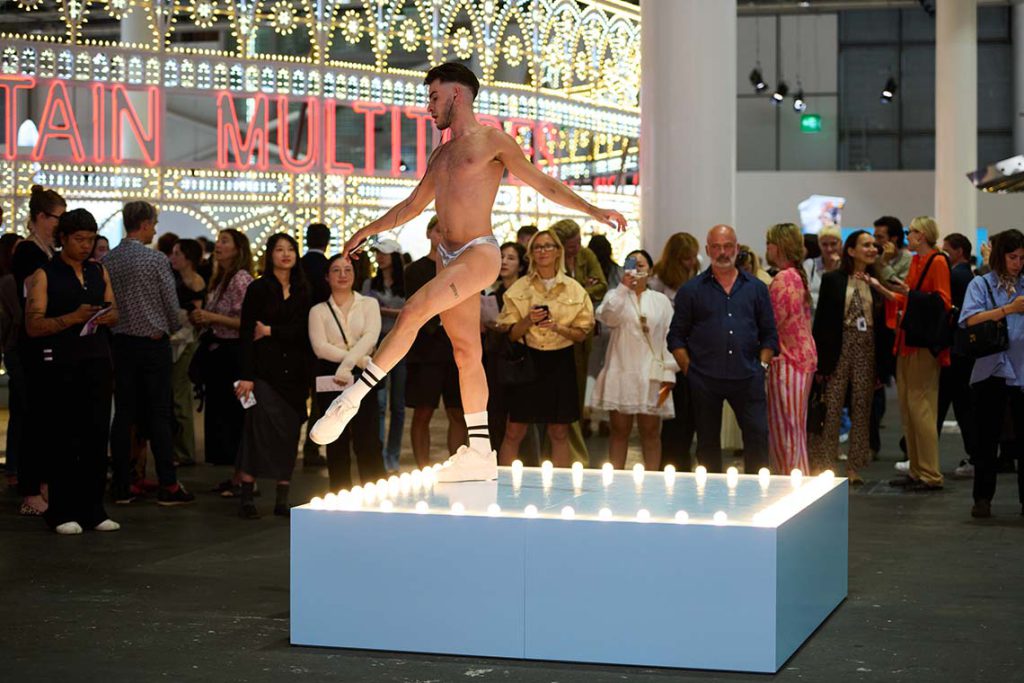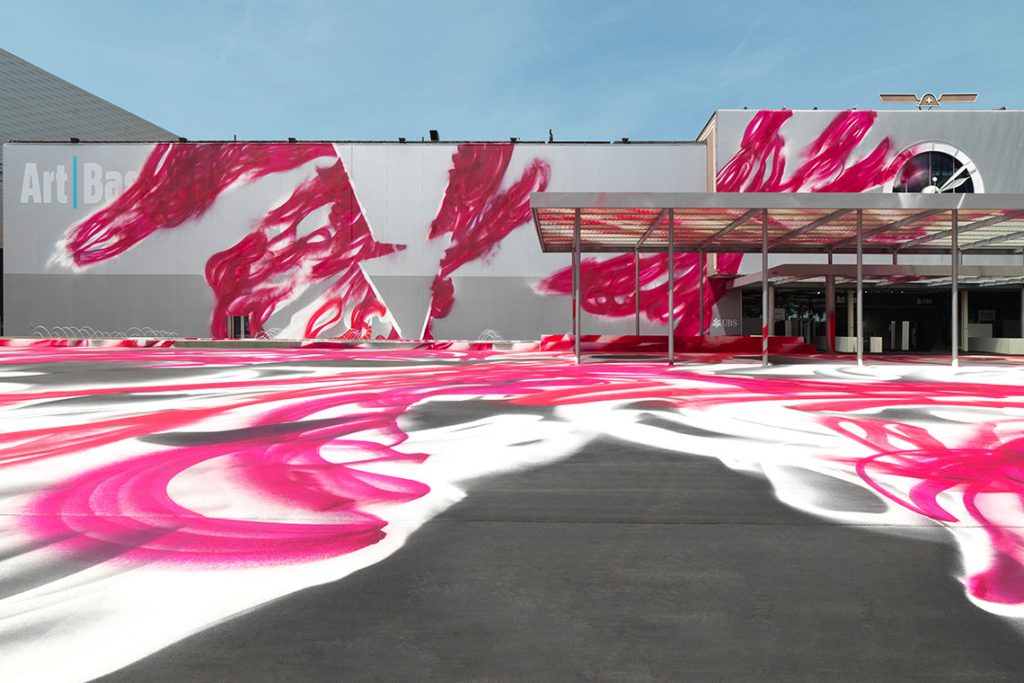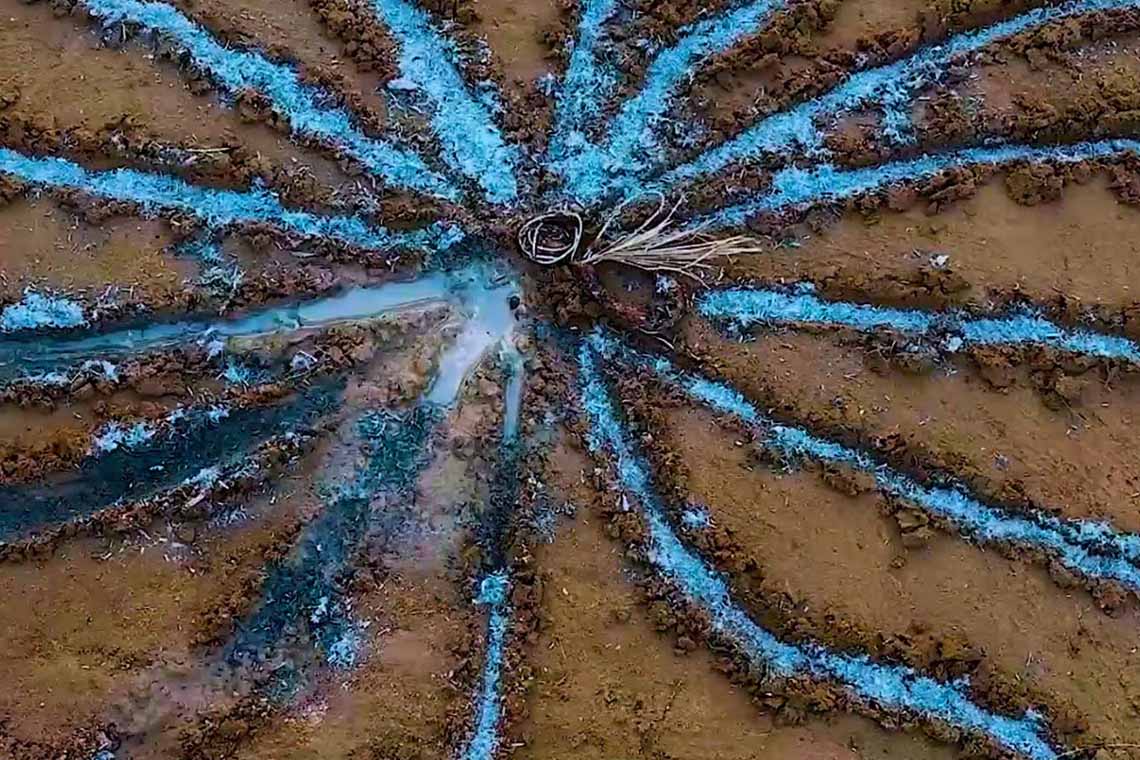Art Basel in Basel’s 2025 edition is as high-tempo as ever despite the challenges of the art market, with established and emerging talent keeping pace with visitors’ voracious appetite for art.
It is naive to expect quiet at an art fair – because there never is. Gallerists and artists are on edge, brimming with anxious confidence. The art market is under pressure, yet continues to resist the threat of recession.
On 16 June, Art Basel in Basel opened its doors to its First Choice guests. Everyone who is anyone was there – bubbles in one hand, Instagram in the other. Champagne bottles popped, oysters were on their way. Curated by Giovanni Carmine, Unlimited is Art Basel’s pioneering platform for projects that transcend the classical art fair stand. Typical booths are absent – replaced by people and bombastic artworks that overwhelm this sector of the fair. Everyone is trying to say something about the turbulent times in which we live. Language dominates, with text appearing in nearly every piece, rendered in every conceivable way. Strip out the words and you’d have an essay waiting to happen. The written word demands to be read, no matter the scale or medium. Yet in the maze of the art fair, you can wander through every message and still emerge in a state of comprehensive confusion.
From the back of the queue, we catch caught a glimpse of Marinella Senatore’s We Rise by Lifting Others. It’s bright, it’s big, and it shouts in neon-lit caps.

In Walid Raad’s Sweet Talk: Commissions (Beirut)_ Solidere, 1994–1997 (2019) a kaleidoscopic looping of destruction invites viewers to linger. This immersive, multi-channel video echoes a distant reality – one that becomes a mirror for our own. Not far away, a journey begins with two carabao sculptures and continues with a trail of mixed-media installations – imagine Noah’s Ark unpacked. Atelier Van Lieshout’s The Voyage – A March to Utopia holds explosive icons of labour, remnants of political stances and weighty societal commentary, yet ultimately takes us nowhere in particular.
At the trail’s end is Desert Seeds (2025) by Sharjah-born Ayan Farah. Gentle and soft, wrinkled and stretched, it appears fragile despite its 12.8-metre scale. Its blush hues come from clay sourced in Somalia’s Sanaag region, combined with cloud-seeded water from the UAE. Embroidered monochromatic images of extinct desert flora gently interrupt its surface. Impossible to miss is Danh Vo’s In God We Trust (2025), which commands attention even from a distance. The American flag disintegrates – and we have become its audience.
It’s been decades since Felix Gonzalez-Torres’s “Untitled” (Go-Go Dancing Platform) first premiered, yet in 2025 we are still haunted by the sorrow and grief embedded in this USD 16 million artwork. Everyone anticipates a silent disco. The dancer is on the way. Through the crowd, a man in silver skimpy briefs, athletic socks and white Vans sneakers walks nonchalantly. Wired headphones on, iPod in hand. The lightbulb-studded platform awaits. “Imigrante” is tattooed on the dancer’s thigh. He twerks, slaps his butt, dancing for no one but himself. Five minutes pass. He stops. As he descends from the platform, he leaves the same way he arrived – quietly. The dancer’s absence lingers. The platform is now haunted, and the crowd resumes its former state.

Outside is the Messeplatz Project, a site-specific work by Katharina Grosse. Imagine Godzilla with a spray gun. CHOIR transforms urban surfaces and architectural elements, extending her exploration into the possibilities of painting.
Across the bridge, overlooking the Rhine, the fair’s Parcours sector embarks on another journey, one that is free and open to the public. This year’s edition is again curated by Stefanie Hessler, director of the Swiss Institute in New York. More than 20 ambitious projects by international emerging artists are on view. Among them is Fiona Banner aka The Vanity Press’s DISARM FLAGS (ISBN 978-1-913983-35-2), featuring tattooed body parts etched with words about conflict, politics and language. At Pfister Werkstatt by Krafft Basel, Mohammad Alfaraj presents The Date Fruit of Knowledge – a poignant fable about a bulbul bird’s hunger for knowledge and its consequences. Filipino-Dutch artist Martha Atienza’s TARONG/KAONGKOD (2019) plays across three screens in a retail store as images of Filipino fisherfolk from the Bantayan Islands contrast with a kilo of frozen fish that is about to be bought.
Back at the main fair, another hall features two floors and hundreds of galleries, divided into sectors: Galleries, Feature, Statements, Premiere, and Kabinett. The majority of the art world is here, from superstars to emerging talents, and including – surprisingly –artworks of the elusive Martin Margiela. Paintings remain ever-present. Etel Adnan’s small work at Mennour demands quiet attention. Issy Wood’s stretched green rabbit in I’m Late / I’m Late (2025) at Carlos/Ishikawa, is a delight. Antonio López’s Untitled (2025), at Balice Hertling invites a delicate, meticulous gaze.

Some works depict domestic objects stripped of utility, such as Maha Malluh’s Fatawa II (Food For Thought) (2023), where cassette tapes are arranged in a grid within a wooden tray. At carlier | gebauer, walking sticks loom above the crowd in Tarik Kiswanson’s A Century (2024). UAE legend Hassan Sharif’s Plastic and Wire (1986) rests on a pedestal and demands to be looked at. London-based newcomer Ginny on Frederick presents Alexandra Metcalf’s transformed antique grandfather clocks, each named after men from her life.
Seeking stillness at an art fair – especially the world’s biggest – is absurd. But just as I was ready to surrender to the noise, I found solace at Chantal Crousel’s Kabinett presentation of Mona Hatoum. Quietly in the corner, Hatoum’s grid works whisper a metaphor – of politics, of importance, of something that must be heard.
In a recent interview, chief artistic officer and global director of Art Basel Fairs, Vincenzo de Bellis, reflected on how art fairs have changed over the past decade. “Art fairs function as agile, high-frequency stages where new ideas surface, new artists break through and the market reacts in real time. In that sense, they are not in competition with biennials – they are complementary. One offers depth, the other immediacy.” It was naive of me to expect quiet at Art Basel in Basel. I should’ve looked elsewhere.



